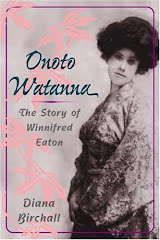Jane Austen's Suffragette Banner
Pictures give some idea of the size and spirit of the "Great Demonstration" on what came to be called Women's Sunday:
Among the marchers were members of the Women Writers' Suffrage League, newly founded by the playwright Cicely Hamilton and Bessie Hatton of the Women's Social and Political Union. The group's motto was: "To obtain the vote for women on the same terms as it is or may be granted to men. Its methods are those proper to writers - the use of the pen."
Edith Craig and Cicely Hamilton
Cicely Hamilton had a hit play, "Diana of Dobson's," that year, about a department store worker. Her famous Suffrage play, "How the Vote was Won," was a hit in 1909. Edith Craig, daughter of actress Ellen Terry, was a member of the Women Actresses' Suffrage League, also founded in 1908.
The Illustrated London News ran a piece on "The Women Militant: Leaders of the Suffragist Procession and the Banners Commemorating Great Woman of All Ages." Seventy banners were created and carried for the Hyde Park demonstration.
Suffragettes making banners for the Hyde Park march
Elizabeth Robins, actress turned writer, and first President of the League, wrote, "The qualification for membership is the publication or production of a book, article, story, poem or play for which the author has received payment, and a subscription of 2s . 6d. to be paid annually...Women writers are urged to join the League. A body of writers working for a common object cannot fail to influence public opinion."
Other women writers who joined the organisation included Elizabeth Robins, Charlotte Despard, Alice Meynell, Olive Schreiner, May Sinclair, Marie Belloc Lowndes, Mrs. Israel Zangwill, and Mrs. Havelock Ellis. Some familiar names, some not; fun to google them all. Elizabeth Robins is one of the most interesting.
Elizabeth Robins as Hedda Gabler
The banners that floated above the heads of the women writers are a fascinating collection. I like that they chose to celebrate so many famous women writers of the past. Here are a few of them:
And here is an piquant assortment of others:
You can see all the banners! Here: http://vads.ahds.ac.uk/collections/FSB.html
And now, for your cat picture. The song "March of the Women" should be sung while viewing. Here is the song:
The sister cats, as you see, are appropriately Shoulder to Shoulder.
Shoulder to Shoulder: Martial and Catullus
with their Tails as Banners


















